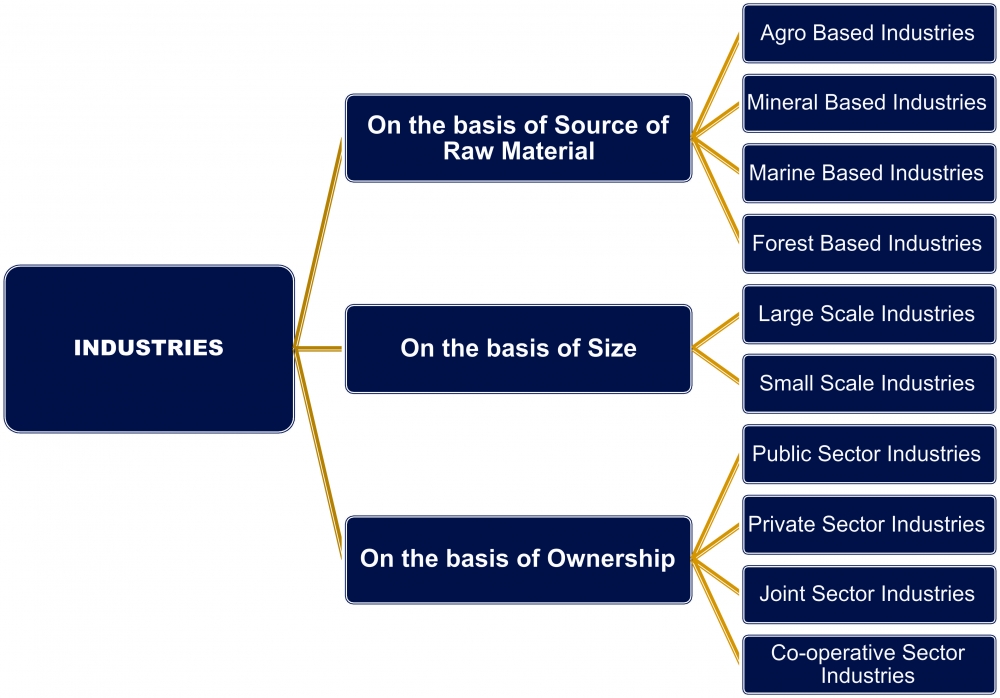Class VIII: Chapter 5 (Industries) Question and Answers
Q1. Define the term: (a) Manufacturing (b) Industry.
Ans: (a) Manufacturing: Production of goods in large quantities after processing from raw material to more valuable products is called "Manufacturing".
(b) Industry: Industry refers to an economic activity that is concerned with the production of goods, extraction of minerals or the provision of services.
Q2. Which Indian city is known as "The Manchester of India"?
Ans: Ahmedabad city is known as "The Manchester of India"
Q3. List out the physical and human factors of industrial location.
Ans: Physical Factors: Land, water, power, raw material, etc.
Human Factors: Capital, labour, policies, market, technology, transportation, communication, etc.
Q4. What do you mean by information technology?
Ans: The information technology industry deals in the storage, processing and distribution of information through Radio, Television, Telephones, Cellular Phones, Computers, Laptops, etc.
Q5. Manufacturing industries are important for the economic development of the country, discuss.
Ans: Following are importance of manufacturing industries for the economic development of the country:
(a) Industrial growth helps in modernizing the agricultural activities by providing machinery, chemicals, irrigation facilities, insecticides, pesticides, etc.
(b) Industrial growth helps in reducing the unemployment and poverty.
(c) Industrial growth can earn foreign exchange by exporting the finished goods and thus, can expand its trade and commerce.
(d) Industrial growth helps in improving the standard of living of the people.
Q6. Enlist the four mitigation strategies to reduce the impact of industrial accidents.
Ans: Following are the mitigation strategies to reduce the impact of industrial accidents:
(a) Densely populated residential areas should be separated far away from the industrial areas.
(b) People staying in the surrounding area of industries should be aware of the storage of toxins or hazardous substances and their possible effects in case if any accident occurs.
(c) Fire warning and fighting system should be improved.
(d) Storage capacity of toxic substances should be limited.
(e) Pollution dispersion qualities in the industries should be improved.
Q7. Explain the factors favourable for the development of the IT industry in Bangaluru.
Ans: Following are the factors favourable for the development of the IT industry in Bangaluru:
(a) Bangalore is located on the Deccan Plateau from where it gets the name 'Silicon Plateau'.
(b) The city is known for its mild climate throughout the year. Pleasant weather, low cost of living, makes it an ideal place for living.
(c) Good transport facility, availability of skilled and experienced professionals.
(d) The city has many leading educational institutes.
(e) More than 100 multinational and software companies have established their business.
(f) The government of Karnataka was the first to sanction the establishment of IT industry.
Q8. Discuss the locational advantages for the development of the cotton textile industry in Ahmedabad.
Ans: Following are the locational advantages for the development of cotton textile industry in Ahmedabad:
(a) Located in Gujarat on the banks of the Sabarmati River.
(b) Situated very close to cotton growing area. Raw material is easy availability.
(c) The climate is ideal for spinning and weaving.
(d) The flat terrain and easy availability of land is suitable for the establishment of the mills.
(e) The densely populated states of Gujarat and Maharashtra provide both skilled and semi-skilled labour.
(f) Well developed road and railway network permits easy transportation of textiles to different parts of the country, thus providing easy access to the market.
(g) Mumbai and Kandla ports nearby facilitates import of machinery and export of cotton textiles.
Q9. Compare and contrast the development of the iron and steel industry in Pittsburgh and in Jamshedpur.
Ans: Iron and Steel Industry in Pittsburgh:
(a) Pittsburgh is an important steel city of the United States of America. City is also known as "Iron City"
(b) In mid 19th century processing of Iron began in Pittsburgh.
(c) Some of the raw material such as coal is available locally, while the iron ore comes from the iron mines at Minnesota, about 1500 km from Pittsburgh. Between these mines and Pittsburgh is one of the world's best routes for shipping ore cheaply – the famous Great Lakes waterway. Trains carry the ore from the Great Lakes to the Pittsburgh area.
(d) The Ohio, the Monongahela and Allegheny rivers provide adequate water supply.
(e) Pittsburgh has a favourable topography, temperate climate, skilled labour and market, which make this place favourable for the development of Iron & Steel industry.
Iron and Steel Industry in Jamshedpur:
(a) Before 1947, there was only one iron and steel plant in the country – Tata Iron and Steel Company Limited (TISCO).
(b) TISCO was started in 1907 by Jamshedji N. Tata at Sakchi in the Singhbhum district of Jharkhand, but the production started in 1910. Later on Sakchi was renamed as Jamshedpur.
(c) Sakchi was only 32 km away from Kalimati station on the Bengal-Nagpur railway line. It was close to the iron ore, coal and manganese deposits as well as to Kolkata, which provided a large market. TISCO gets coal from Jharia coalfields, and iron ore, limestone, dolomite and manganese from Orissa and Chhattisgarh.
(d) The Kharkai and Subarnarekha rivers ensured sufficient water supply.
(e) Government initiatives lead to rapid industrial growth in India.
Q10. Draw a flow chart to explain the classification of industries.
Ans:

-----x-----X-----x-----

There are no published comments.
New comment